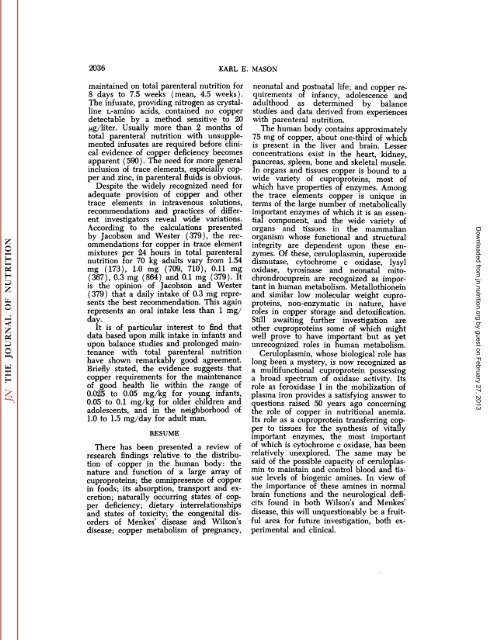conspectus of researchon copper metabolism and requirements
conspectus of researchon copper metabolism and requirements
conspectus of researchon copper metabolism and requirements
Create successful ePaper yourself
Turn your PDF publications into a flip-book with our unique Google optimized e-Paper software.
2036 KARL E. MASON<br />
maintained on total parenteral nutrition for<br />
8 days to 7.5 weeks (mean, 4.5 weeks).<br />
The infúsate, providing nitrogen as crystal<br />
line L-amino acids, contained no <strong>copper</strong><br />
detectable by a method sensitive to 20<br />
itg/liter. Usually more than 2 months <strong>of</strong><br />
total parenteral nutrition with unsupplemented<br />
infusâtesare required before clini<br />
cal evidence <strong>of</strong> <strong>copper</strong> deficiency becomes<br />
apparent (590 ). The need for more general<br />
inclusion <strong>of</strong> trace elements, especially cop<br />
per <strong>and</strong> zinc, in parenteral fluids is obvious.<br />
Despite the widely recognized need for<br />
adequate provision <strong>of</strong> <strong>copper</strong> <strong>and</strong> other<br />
trace elements in intravenous solutions,<br />
recommendations <strong>and</strong> practices <strong>of</strong> differ<br />
ent investigators reveal wide variations.<br />
According to the calculations presented<br />
by Jacobson <strong>and</strong> Wester (379), the rec<br />
ommendations for <strong>copper</strong> in trace element<br />
mixtures per 24 hours in total parenteral<br />
nutrition for 70 kg adults vary from 1.54<br />
mg (173), 1.0 mg (709, 710), 0.11 mg<br />
(367), 0.3 mg (864) <strong>and</strong> 0.1 mg (379). It<br />
is the opinion <strong>of</strong> Jacobson <strong>and</strong> Wester<br />
(379) that a daily intake <strong>of</strong> 0.3 mg repre<br />
sents the best recommendation. This again<br />
represents an oral intake less than 1 mg/<br />
day.<br />
It is <strong>of</strong> particular interest to find that<br />
data based upon milk intake in infants <strong>and</strong><br />
upon balance studies <strong>and</strong> prolonged main<br />
tenance with total parenteral nutrition<br />
have shown remarkably good agreement.<br />
Briefly stated, the evidence suggests that<br />
<strong>copper</strong> <strong>requirements</strong> for the maintenance<br />
<strong>of</strong> good health lie within the range <strong>of</strong><br />
0.025 to 0.05 mg/kg for young infants,<br />
0.05 to 0.1 mg/kg for older children <strong>and</strong><br />
adolescents, <strong>and</strong> in the neighborhood <strong>of</strong><br />
1.0 to 1.5 mg/day for adult man.<br />
RESUME<br />
There has been presented a review <strong>of</strong><br />
research findings relative to the distribu<br />
tion <strong>of</strong> <strong>copper</strong> in the human body: the<br />
nature <strong>and</strong> function <strong>of</strong> a large array <strong>of</strong><br />
cuproproteins; the omnipresence <strong>of</strong> <strong>copper</strong><br />
in foods; its absorption, transport <strong>and</strong> ex<br />
cretion; naturally occurring states <strong>of</strong> cop<br />
per deficiency; dietary interrelationships<br />
<strong>and</strong> states <strong>of</strong> toxicity; the congenital dis<br />
orders <strong>of</strong> Menkes' disease <strong>and</strong> Wilson's<br />
disease; <strong>copper</strong> <strong>metabolism</strong> <strong>of</strong> pregnancy,<br />
neonatal <strong>and</strong> postnatal life; <strong>and</strong> <strong>copper</strong> re<br />
quirements <strong>of</strong> infancy, adolescence <strong>and</strong><br />
adulthood as determined by balance<br />
studies <strong>and</strong> data derived from experiences<br />
with parenteral nutrition.<br />
The human body contains approximately<br />
75 mg <strong>of</strong> <strong>copper</strong>, about one-third <strong>of</strong> which<br />
is present in the liver <strong>and</strong> brain. Lesser<br />
concentrations exist in the heart, kidney,<br />
pancreas, spleen, bone <strong>and</strong> skeletal muscle.<br />
In organs <strong>and</strong> tissues <strong>copper</strong> is bound to a<br />
wide variety <strong>of</strong> cuproproteins, most <strong>of</strong><br />
which have properties <strong>of</strong> enzymes. Among<br />
the trace elements <strong>copper</strong> is unique in<br />
terms <strong>of</strong> the large number <strong>of</strong> metabolically<br />
important enzymes <strong>of</strong> which it is an essen<br />
tial component, <strong>and</strong> the wide variety <strong>of</strong><br />
organs <strong>and</strong> tissues in the mammalian<br />
organism whose functional <strong>and</strong> structural<br />
integrity are dependent upon these en<br />
zymes. Of these, ceruloplasmin, Superoxide<br />
dismutase, cytochrome c oxidase, lysyl<br />
oxidase, tyrosinase <strong>and</strong> neonatal mitochrondrocuprein<br />
are recognized as impor<br />
tant in human <strong>metabolism</strong>. Metallothionein<br />
<strong>and</strong> similar low molecular weight cupro<br />
proteins, non-enzymatic in nature, have<br />
roles in <strong>copper</strong> storage <strong>and</strong> detoxification.<br />
Still awaiting further investigation are<br />
other cuproproteins some <strong>of</strong> which might<br />
well prove to have important but as yet<br />
unrecognized roles in human <strong>metabolism</strong>.<br />
Ceruloplasmin, whose biological role has<br />
long been a mystery, is now recognized as<br />
a multifunctional cuproprotein possessing<br />
a broad spectrum <strong>of</strong> oxidase activity. Its<br />
role as feroxidase I in the mobilization <strong>of</strong><br />
plasma iron provides a satisfying answer to<br />
questions raised 50 years ago concerning<br />
the role <strong>of</strong> <strong>copper</strong> in nutritional anemia.<br />
Its role as a cuproprotein transferring cop<br />
per to tissues for the synthesis <strong>of</strong> vitally<br />
important enzymes, the most important<br />
<strong>of</strong> which is cytochrome c oxidase, has been<br />
relatively unexplored. The same may be<br />
said <strong>of</strong> the possible capacity <strong>of</strong> ceruloplas<br />
min to maintain <strong>and</strong> control blood <strong>and</strong> tis<br />
sue levels <strong>of</strong> biogenic amines. In view <strong>of</strong><br />
the importance <strong>of</strong> these amines in normal<br />
brain functions <strong>and</strong> the neurological defi<br />
cits found in both Wilson's <strong>and</strong> Menkes'<br />
disease, this will unquestionably be a fruit<br />
ful area for future investigation, both ex<br />
perimental <strong>and</strong> clinical.<br />
Downloaded from<br />
jn.nutrition.org<br />
by guest on February 27, 2013
















